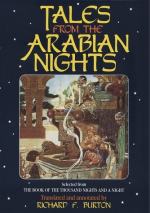The stories in Galland’s last six vols. may be divided into two classes, viz., those known to occur in genuine texts of The Nights, and those which do not. To the first category belong Nos. 7, 8, 59, 153 and 170; and some even of these are not found in Galland’s own Ms., but were derived by him from other sources. The remaining tales (Nos. 191-198) do not really belong to The Nights; and, strange to say, although they are certainly genuine Oriental tales, the actual originals have never been found. I am inclined to think that Galland may, perhaps, have written and adapted them from his recollection of stories which he himself heard related during his own residence in the East, especially as most of these tales appear to be derived rather from Persian or Turkish than from Arabian sources.
The following Preface appeared in vol. 9 which I translate from Talander’s German edition, as the original is not before me:
“The two stories with which the eighth volume concludes do not properly belong to the Thousand and One Nights. They were added and printed without the previous knowledge of the translator, who had not the slightest idea of the trick that had been played upon him until the eighth volume was actually on sale. The reader must not, therefore, be surprised that the story of the Sleeper Awakened, which commences vol. 9, is written as if Scheherazade had related it immediately after the story of Ganem, which forms the greater part of vol. 8. Care will be taken to omit these two stories in a new edition, as not belonging to the work.”
It is, perhaps, not to be wondered at that when the new edition was actually published, subsequently to Galland’s death, the condemned stories were retained, and the preface withdrawn; though No. 170 still reads as if it followed No. 8.
The information I have been able to collect respecting the disputed tales is very slight. I once saw a Ms. advertised in an auction catalogue (I think that of the library of the late Prof. H. H. Wilson) as containing two of Galland’s doubtful tales, but which they were was not stated. The fourth and last volume of the Ms. used by Galland is lost; but it is almost certain that it did not contain any of these tales (compare Payne, ix. 265 note).
The story of Zeyn Alasnam (No. 191) is derived from the same source as that of the Fourth Durwesh, in the well-known Hindustani reading-book, the Bagh o Bahar. If it is based upon this, Galland has greatly altered and improved it, and has given it the whole colouring of a European moral fairy tale.
The story of Ali Baba (No. 195) is, I have been told, a Chinese tale. It occurs under the title of the Two Brothers and the Forty-nine Dragons in Geldart’s Modern Greek Tales. It has also been stated that the late Prof. Palmer met with a very similar story among the Arabs of Sinai (Payne, ix. 266).
The story of Sidi Nouman (No 194b) may have been based partly upon the Third Shaykh’s Story (No. 1c), which Galland omits. The feast of the Ghools is, I believe, Greek or Turkish, rather than Arabic, in character, as vampires, personified plague, and similar horrors are much commoner in the folk-lore of the former peoples.




